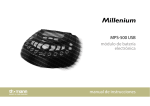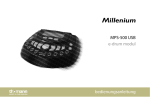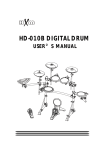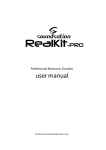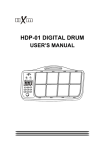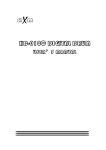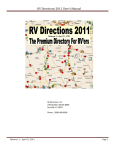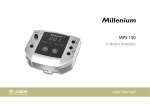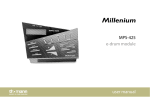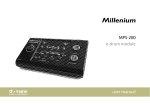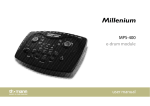Download MPS-500 e-drum modul user manual
Transcript
MPS-500 e-drum modul user manual Musikhaus Thomann e.K. Treppendorf 30 96138 Burgebrach Germany Telephone: +49 (0) 9546 9223-0 E-mail: [email protected] Internet: www.thomann.de 11.02.2014, ID: 305855 (V2) Table of contents Table of contents 1 General notes............................................................................................................................................... 1.1 Further information........................................................................................................................... 1.2 Notational conventions.................................................................................................................... 1.3 Symbols and signal words............................................................................................................... 5 6 7 9 2 Safety instructions.................................................................................................................................. 11 3 Features....................................................................................................................................................... 14 4 Installation.................................................................................................................................................. 15 5 Operating elements............................................................................................................................... 17 6 Operation.................................................................................................................................................... 6.1 Functions............................................................................................................................................. 6.2 Playing, customising and accompanying songs.................................................................. 6.3 Drum kits ............................................................................................................................................ 6.4 Pad settings........................................................................................................................................ 6.5 Metronome click settings.............................................................................................................. 6.6 Record function................................................................................................................................ 24 24 27 32 38 45 49 MPS-500 3 Table of contents 6.7 Reset to factory default settings................................................................................................. 51 7 Technical specifications....................................................................................................................... 53 8 Connector and pin assignments...................................................................................................... 54 9 Cleaning....................................................................................................................................................... 56 10 Protecting the environment.............................................................................................................. 57 11 Appendix..................................................................................................................................................... 58 11.1 Kit list.................................................................................................................................................. 58 11.2 MIDI implementation................................................................................................................... 60 e-drum modul 4 General notes 1 General notes This manual contains important instructions for the safe operation of the unit. Read and follow the safety instructions and all other instructions. Keep the manual for future reference. Make sure that it is available to all those using the device. If you sell the unit please make sure that the buyer also receives this manual. Our products are subject to a process of continuous development. Thus, they are subject to change. MPS-500 5 General notes 1.1 Further information On our website (www.thomann.de) you will find lots of further information and details on the following points: Download This manual is also available as PDF file for you to download. Keyword search Use the search function in the electronic version to find the topics of interest for you quickly. Online guides Our online guides provide detailed information on technical basics and terms. Personal consultation For personal consultation please contact our technical hotline. Service If you have any problems with the device the customer service will gladly assist you. e-drum modul 6 General notes 1.2 Notational conventions This manual uses the following notational conventions: Letterings The letterings for connectors and controls are marked by square brackets and italics. Examples: [VOLUME] control, [Mono] button. Displays Texts and values displayed on the device are marked by quotation marks and italics. Examples: ‘24ch’ , ‘OFF’ . MPS-500 7 General notes Instructions The individual steps of an instruction are numbered consecutively. The result of a step is indented and highlighted by an arrow. Example: 1. Switch on the device. 2. Press [Auto]. ð Automatic operation is started. 3. Text input Switch off the device. Text inputs that are carried out on the device are indicated by typewriter font. Example: 2323 Cross-references References to other locations in this manual are identified by an arrow and the specified page number. In the electronic version of the manual, you can click the cross-reference to jump to the specified location. Example: See Ä ‘Cross-references’ on page 8. e-drum modul 8 General notes 1.3 Symbols and signal words In this section you will find an overview of the meaning of symbols and signal words that are used in this manual. Signal word Meaning DANGER! This combination of symbol and signal word indicates an immediate dangerous situation that will result in death or serious injury if it is not avoided. CAUTION! This combination of symbol and signal word indicates a possible dangerous situation that can result in minor injury if it is not avoided. NOTICE! This combination of symbol and signal word indicates a possible dangerous situation that can result in material and environmental damage if it is not avoided. MPS-500 9 General notes Warning signs Type of danger Warning – danger zone. e-drum modul 10 Safety instructions 2 Safety instructions Intended use Drum modules are intended to be used for converting digital trigger signals from drum pads to various percussion sounds. Use the unit only as described in this manual. Any other use or use under other operating conditions is considered to be improper and may result in personal injury or property damage. No liability will be assumed for damages resulting from improper use. This device may be used only by persons with sufficient physical, sensorial, and intellectual abilities and having corresponding knowledge and experience. Other persons may use this device only if they are supervised or instructed by a person who is responsible for their safety. MPS-500 11 Safety instructions Safety DANGER! Danger for children Ensure that plastic bags, packaging, etc. are disposed of properly and are not within reach of babies and young children. Choking hazard! Ensure that children do not detach any small parts (e.g. knobs or the like) from the unit. They could swallow the pieces and choke! Never let children unattended use electrical devices. CAUTION! Possible hearing damage With loudspeakers or headphones connected, the device can produce volume levels that may cause temporary or permanent hearing impairment. Do not operate the device permanently at a high volume level. Decrease the volume level immediately if you experience ringing in your ears or hearing impairment. e-drum modul 12 Safety instructions NOTICE! Operating conditions This device has been designed for indoor use only. To prevent damage, never expose the device to any liquid or moisture. Avoid direct sunlight, heavy dirt, and strong vibrations. NOTICE! External power supply The device is powered by an external power supply. Before connecting the external power supply, ensure that the input voltage (AC outlet) matches the voltage rating of the device and that the AC outlet is protected by a residual cur‐ rent circuit breaker. Failure to do so could result in damage to the device and pos‐ sibly the user. Unplug the external power supply before electrical storms occur and when the device is unused for long periods of time to reduce the risk of electric shock or fire. MPS-500 13 Features 3 Features n n n n n n n n n 418 voices 50 pre-installed drum kits, 30 user kits 52 pre-installed songs, 10 user songs Click, EQ and stroke counter Recording function MIDI functions Flexible assigning of pad voices Connections for headphones, AUX and MIDI Automatic switchoff e-drum modul 14 Installation 4 Installation Setup, connecting pads and pedals Setup and installation of the pads and pedals are described in detail in the included setup guide. Finally, check that all connecting cables between the pads and the drum module are connected correctly. Connecting the power supply Connect the supplied power adapter to the ‘POWER’ input on the rear panel of the drum module. Then insert the mains plug into a mains wall outlet. Connecting the pads Connect the supplied sub-D plug of the pad connector cable to the sub-D input socket on the rear panel of the drum module. Connecting USB devices Connect your computer (Windows Vista/XP®, Mac) to the USB connection on the rear panel of the drum module. Connecting audio devices Connect the inputs of your amplifier or powered speaker to the ‘LINE OUT’ output jack on the rear panel of the drum module. MPS-500 15 Installation Connecting headphones Connect your stereo headphones to the PHONE output on the rear panel of the drum module. Connecting CD or MP3 player Connect audio devices like CD or MP3 player, etc. to the ‘LINE IN’ input on the rear panel of the drum module. e-drum modul 16 Operating elements 5 Operating elements Front panel MPS-500 17 Operating elements 1 Backlit LCD Display of song, kit and voice number as well as various setup parameters. 2 [TEMPO] Use this button to adjust metronome and song playback speed. 3 [CLICK] Use this button to switch the metronome on of off and to open the Click menu 4 [MODE] Use this button to toggle operating modes. 5 [ENTER] Input button to confirm a selection or adjustment. 6 [EDIT] Use this button to open the programming menu. e-drum modul 18 Operating elements 7 [SETUP] Use this button to open the device settings menu. 8 [EXIT] Return key to exit a menu or to discard changes. 9 Pad selection area Use this buttons to activate pads and kits. 10 Rotary control [–] / [+] To increase or decrease the value of the currently selected parameter. 11 Record button Use this button to start the recording. 12 Start / stop button Use this button to start or stop song playback and to stop the recording. 13 [COUNT] Use this button to activate the Count mode (stroke counter). MPS-500 19 Operating elements 14 [SONG] Use this button to activate the Demo mode and to playback user songs. 15 [KIT] Use this button to open the Kit menu. e-drum modul 20 Operating elements Rear panel MPS-500 21 Operating elements 16 TRIGGER Sub-D input to connect the pads using the pad cable supplied. 17 LINE OUT Output socket to connect an amplifier or powered speaker. 18 LINE IN Input socket to connect audio devices like CD or MP3 players, etc. 19 VOLUME Rotary control to adjust the headphones volume. 20 PHONE Headphones outlet. 21 USB USB port to connect a computer with USB-MIDI interface. e-drum modul 22 Operating elements 22 ON / OFF Main switch to turn the unit on or off. 23 POWER Connector socket for the power adapter. MPS-500 23 Operation 6 Operation 6.1 Functions Switching on Check for proper connection of all cables before switching the unit on. Before switching the unit on, turn the [VOLUME] control down to minimum. Use the main switch [ON/OFF] on the rear panel to turn the unit on. Automatic switchoff When the drum module is not used, it will switch off automatically after 20 minutes. To switch it on again, press the [ON/OFF] push button. Adjusting the volume To set the volume, hit a pad while slowly turning the [VOLUME] control clockwise. e-drum modul 24 Operation Selecting a drum kit A drum kit is a compilation in which each trigger is assigned to a certain sound and several sound parameters. By selecting a drum kit, you can tailor the sound of your e-drum kit in sec‐ onds to the desired style of music. In addition to the 50 preset drum kits, you can create and save 30 user drum kits (for more information, see Ä Chapter 11.1 ‘Kit list’ on page 58 and ). 1. Press the [KIT] button. ð The display shows the number and description of the first preset kit in ‘01 xx’ format. The indicator LED of the [KIT] button lights up. 2. Use the rotary control [–] / [+] to select the desired kit. or … 1. Press the [KIT] button twice. ð The display shows the first user kit in ‘U01 UserKit01’ format. The indicator LED of the [KIT] button lights up. 2. Use the rotary control [–] / [+] to select the desired user kit. MPS-500 25 Operation In factory default condition, all user kits are assigned to standard settings. User kit programming is described in detail in chapterÄ Chapter 6 ‘Operation’ on page 24. The selected drum kit is instantly active. Click function Press the [CLICK] button to turn the Click function on or off. The indicator LED of this button is lit when the Click is turned on. All setting options are described in detail in chapter . Stroke counter Use this function to count the strokes within a certain period of time. 1. Press the [SETUP] button to open the device settings menu. 2. Use the rotary control [–] / [+] to select the parameter ‘Count Sensitivity’ . 3. Press [ENTER] to confirm and then adjust the touch sensitivity with the rotary control [–] / [+] in a range from 0 to 24 (default value is 16). 4. Press [ENTER] to confirm. 5. Press the [COUNT] button to activate the counter mode. ð The display indicates the current counting period ( ‘Count Time’ ). e-drum modul 26 Operation 6. Use the rotary control [–] / [+] to adjust the desired period of time (setting range: ‘01’ , ‘02’ and ‘03’ minutes). 7. Press [ENTER] to confirm. ð ‘Ready’ is flashing in the display. 8. Hit any pad to start the count function. ð The display continuously indicates the number of registered stokes and the remaining time in ‘000’ / ‘Cnt-SecXXX’ format. 9. By the end of the set counting period you hear a short beep. ð The display indicates the total number of registered strokes in ‘000’ / ‘Counted’ format. 10. Press [ENTER] to re-start the counting function, press [EXIT] to quit the count mode. 6.2 Playing, customising and accompanying songs Playback of pre-installed songs Your digital drum module offers 52 pre-installed songs in total. You can play them individually or in a continuous sequence. MPS-500 27 Operation 1. Press the [SONG] button. ð The indicator LED of the button lights up, ‘All Demo’ appears in the display. 2. Press the Start/Stop button. ð The indicator LED of the button lights up and the continuous playback starts after three seconds with song number ‘01’ . or … 1. Press the [SONG] button. 2. Use the rotary control [–] / [+] to select the desired song within 3 seconds. 3. Press the Start/Stop button. ð The indicator LED of the button lights up, the playback of the selected song begins. e-drum modul 28 Operation Tempo and time signature of the currently playing song are shown in the second line of the display. Press the Start/Stop button again to stop the playback. Accompanying pre-installed songs You digital drum module offers three accompanying modes for practising with pre-installed songs: n FULL In this mode, you hear the whole song when accompanying, i.e. all tracks. n DRUM ONLY In this mode, you hear only the drum track of the song. n DRUM MUTE In this mode, the drum track of the song is muted. Press the [MODE] button to activate the desired mode, until the corresponding indicator appears in the display. To start/stop the playback press the Start/Stop button. MPS-500 29 Operation Playing user songs You digital drum module offers in total 10 memory slots for user songs (see also ). 1. Press the [SONG] button twice. ð The indicator LED of the button lights up, and ‘All U-Song’ appears in the display. 2. Use the rotary control [–] / [+] to select the desired user song. 3. Press the Start/Stop button. ð The indicator LED of the button lights up and the selected song is being played. If you make no selection within three seconds, the display automatically jumps to the user song ‘01’ . If no user-Song was previously saved, the display shows the message ‘Free’ . The device then automatically returns after three seconds to the kit mode. Additionally, tempo and time signature of the currently playing song are shown in the second line of the display. Press the Start/Stop button again to stop the playback. e-drum modul 30 Operation Adjusting song volume 1. Press the [SETUP] button. 2. Use the rotary control [–] / [+] to select the parameter ‘Accomp Vol’ . 3. Press [ENTER] to confirm. ð The current song volume value is flashing in the display. 4. Use the rotary control [–] / [+] to adjust the desired volume in a range from 0 to 24 (default value is 11). 5. Press [ENTER] to confirm. 1. Press the [SETUP] button. 2. Use the rotary control [–] / [+] to select the parameter ‘D.Drum Vol’ . 3. Press [ENTER] to confirm. Adjusting drum set volume ð The current drum set value is flashing in the display. 4. Use the rotary control [–] / [+] to set the desired volume in a range from 0 to 24 (default value is 11). MPS-500 31 Operation 5. Press [ENTER] to confirm. Press [EXIT] to quit the menu at any time. 6.3 Drum kits The 418 pre-installed voices of the drum module can be freely programmed to the connected pads. In other words, you can create your own drum kits and store them in the unit. The fol‐ lowing sections describe how to create your own kits. 1. First, choose the desired kit, see also Ä Chapter 6.1 ‘Functions’ on page 24. 2. Press the [EDIT] button to change to the edit mode. ð The indicator LED of the button lights up. Next to the ‘Edit Mode’ indication, the cur‐ rent kit number is flashing in the display. e-drum modul 32 Operation 3. Press the button of the pad you want to assign a certain voice to. Please note that some pads have multiple assignments, i.e., you have to press a button up to three times to activate the desired trigger (see the chart below). Alternatively, you can activate a trigger directly by playing the corresponding pad area. ð The current setting value along with the symbol for the selected trigger are flashing in the display. The indicator LED of the pad lights up. 4. Use the rotary control [–] / [+] to select the desired voice. 5. Press [ENTER] to confirm the selection. MPS-500 33 Operation 6. Trigger points, display Pad HH Pedal Select the next trigger point you want to programme a voice for, or press the [ENTER] button again to adjust the next parameter. Press [EXIT] to quit the edit mode. Symbol Trigger points, display Pad Hi-Hat pedal HiHat Open Open Hi-Hat HiHat Close Closed Hi-Hat Crash Crash cymbal, arch Crash Edge Crash cymbal, edge Ride Ride cymbal, arch Ride Edge Ride cymbal, edge Snare Snare Snare Rim1 Snare, rim shot 1 Snare Rim2 Snare, rim shot 2 Tom1 Tom 1 Tom1 Rim Tom 1, rim shot e-drum modul 34 Symbol Operation Trigger points, display Pad Tom2 Symbol Trigger points, display Pad Tom 2 Tom2 Rim Tom 2, rim shot Tom3 Tom 3 Tom3 Rim Tom 3, rim shot Kick Bass drum Symbol The possible assignment of the triggers depends on the actual configuration of your drum sets. MPS-500 35 Operation Adjusting trigger parameters To adjust the remaining parameters, please proceed as follows: 1. First, select the desired kit, see Ä Chapter 6.1 ‘Functions’ on page 24. 2. Press the [EDIT] button to change to the edit mode. ð The indicator LED of the button lights up. Next to the ‘Edit Mode’ indication, the cur‐ rent kit number is flashing in the display. 3. Press the [ENTER] button, to jump to the next parameter (see chart below). 4. Use the rotary control [–] / [+] to adjust the respectively shown value. 5. Press [ENTER] to jump to the next parameter, and so on. Parameter, display Description Value range Voice Voice assigned to the trigger 1 … 418 Volume Volume 0 … 127 Pan Trigger position within the stereo panorama –64 … +63 e-drum modul 36 Operation Parameter, display Description Value range Pitch Pitch –10 … +10 Reverb Reverb 0 … 127 Advanced Storing settings After you have assigned all the pads with the desired voices and adjusted the other parame‐ ters, you can save the settings as a user kit in the unit. To do this, follow these steps: 1. Press the [EXIT] button. ð The display will prompt ‘Save it?’ . 2. Press the [ENTER] button to store the settings. ð Next to the ‘User Kit’ indication, the kit number is flashing in the display in ‘U01’ format. 3. Use the rotary control [–] / [+] to select any location. 4. Press [ENTER] again to store your user kit at the desired number. MPS-500 37 Operation In factory default condition, all user kits are assigned with the same standard setting and consecutively saved in the memory as ‘U01’ to ‘U31’ . I.e., you will overwrite an existing standard user kit of the module with every new user kit that you store. Thus, you're prompted ‘Replace it’ for confirmation. Any unsaved changes are discarded when you turn the drum module off. The storage process can be cancelled at any time by pressing [EXIT]. 6.4 Pad settings Equalizer Use the EQ to adjust the trigger sounds of a drum kit globally (see chart below). 1. Press the [SETUP] button and use the rotary control [–] / [+] the select the parameter „Equalizer“. 2. Use the rotary control [–] / [+] to select the desired value (default value is 001). 3. Press [ENTER] to confirm. ð The next parameter appears in the display. e-drum modul 38 Operation 4. Adjust the next parameter or quit the setup menu by pressing [EXIT]. EQ number Description 001 Normal 1 002 Normal 2 003 Bass Boost 004 Bass Mid 005 Moderate 006 Bright Mid 007 Bright 008 Bright High MPS-500 39 Operation Pitch The ‘Master Tune’ parameter allows you to adjust the trigger pitch of a drum kit globally. 1. Press the [SETUP] button and use the rotary control [–] / [+] to select the parameter ‘Master Tune’. 2. Use the rotary control [–] / [+] to select the desired value in a range from –50 to +50. Default value is 0, this corresponds to the concert pitch A (440 Hz). 3. Press [ENTER] to confirm. ð The next parameter appears in the display. 4. Touch sensitivity Adjust the next parameter or quit the setup menu by pressing [EXIT]. The drum module allows you to adjust the touch sensitivity of every pad. 1. Press the [KIT] button to change to the kit mode, followed by the [SETUP] button. 2. Repeatedly press the [ENTER] button or turn the rotary control [–] / [+] until the menu item ‘Advanced’ appears in the display. 3. Press [SETUP] for confirmation to open the setup menu. ð ‘Sensitivity’ is indicated as the first value. e-drum modul 40 Operation 4. Activate the desired pad using the pad select buttons or by striking it. ð The symbol for the pad flashes in the display. Hi-Hat response characteristic 5. Use the rotary control [–] / [+] to set the sensitivity of the pads to the desired value in a range from 1 to 127. 6. Activate the next pad or press [ENTER] to jump to the ‘Dynamic Range’ parameter. If you step on the hi-hat pedal quickly, the usual chick sound is produced, without playing the pad additionally (closed hi-hat). When you release the pedal, the splash sound is generated (open hi-hat). Both pressure and opening point can be set via the drum module. 1. Press the [KIT] button to change to the kit mode, followed by the [SETUP] button. 2. Repeatedly press the [ENTER] button or turn the rotary control [–] / [+] until the menu item ‘Advanced’ appears in the display. 3. Press [SETUP] for confirmation to open the setup menu. 4. Press the [H-PEDAL] button to specify the pressure point for the closed hi-hat. ð The parameter ‘PDL Bottom’ and the current value in ‘000’ format are indicated in the display. The pedal symbol is flashing in the display. MPS-500 41 Operation 5. Step on the hi-hat pedal or press the [H-PEDAL] button and use the rotary control [–] / [+] to set the pressure point to the desired value in a range from 50 to 0. 6. Press [ENTER] to confirm the setting. 7. Repeat steps 1 to 4 and then press the [HI-HAT] button to specify the opening point for the open hi-hat. ð The parameter ‘PDL Top’ and the current value in ‘000’ format are indicated in the display. The pedal symbol is flashing in the display. 8. Dynamic range Step on the hi-hat pedal or press the [HI-HAT] button and use the rotary control [–] / [+] to set the opening point to the desired value in a range from 127 to 51. The drum module allows you to adjust the dynamic range of the individual pads and thus, the signal-to-noise ratio. 1. Press the [KIT] button to change to the kit mode, followed by the [SETUP] button. 2. Repeatedly press the [ENTER] button or turn the rotary control [–] / [+] until the menu item ‘Advanced’ appears in the display. 3. Press [SETUP] for confirmation to open the setup menu. ð Use the rotary control [–] / [+] to change to the second parameter ‘Dynamic Range’. e-drum modul 42 Operation 4. Activate the desired pad using the pad selection buttons or by striking it. ð The symbol of the pad flashes in the display. Velocity 5. Use the rotary control [–] / [+] to adjust the dynamic range of the pads to the desired value in a range from 1 to 127. 6. Activate the next pad or press [ENTER] to jump to the ‘Trigger’ parameter. The drum module allows you to adjust the velocity of the individual pads, i.e., the ratio between strike pressure and resulting volume. 1. Press the [KIT] button to change to the kit mode, followed by the [SETUP] button. 2. Repeatedly press the [ENTER] button or turn the rotary control [–] / [+] until the menu item ‘Advanced’ appears in the display. 3. Press [SETUP] for confirmation to open the setup menu. ð Use the rotary control [–] / [+] to change to the third parameter ‘Trigger’. 4. Activate the desired pad using the pad selection buttons or by striking it. ð The symbol of the pad flashes in the display. 5. Use the rotary control [–] / [+] to adjust the velocity of the pads (Linear, Exp1, Exp2, Log1, Log2, Spline). MPS-500 43 Operation 6. Crosstalk Activate the next pad or press [ENTER] to jump to the ‘Cross Talk’ parameter. When several pads are mounted on one tripod, vibrations may be transferred to other pads and, thus, unwanted sounds are triggered when striking a trigger. This crosstalk can be pre‐ vented by the temporary suppression of the trigger signal. 1. Press the [KIT] button to change to the kit mode, followed by the [SETUP] button. 2. Repeatedly press the [ENTER] button or turn the rotary control [–] / [+] until the menu item ‘Advanced’ appears in the display. 3. Press [SETUP] for confirmation to open the setup menu. ð Use the rotary control [–] / [+] to change to the fourth parameter ‘Cross Talk’. 4. Activate the desired pad using the pad selection buttons or by striking it. ð The symbol of the pad flashes in the display. 5. Use the rotary control [–] / [+] to adjust the signal suppression time to the desired value in a range from 0 to 100. e-drum modul 44 Operation The signal suppression time should be set as short as possible. You can quit the setup menu from any level by pressing [EXIT]. The settings of the menu item ‘Advanced’ are automatically saved (the display briefly shows ‘Saving…’ . 6.5 Metronome click settings The Click menu allows you to adjust the time signature, the volume and the sound of the click in the following order: MPS-500 45 Operation Time signature 1. Press the [CLICK] button twice to enter the Click menu. ð The bar indicator ( ‘Time-Sig’ ) flashes in the second line of the display. 2. Use the rotary control [–] / [+] to select the desired time signature (1–8/2, 1–8/4, 1–8/8, 1–8/16, default value is 4/4). 3. Confirm the selection with [ENTER]. ð In the first line of the display then flashes the indicator of the current click volume. Volume 1. When the display of the current click volume is flashing ( ‘Metro Vol’ ), you can use the rotary control [–] / [+] to adjust the desired volume in a range from 0 to 127 (default value is 96). 2. Confirm the selection with [ENTER]. ð In the first line of the display then flashes the indicator of the current click sound e-drum modul 46 Operation Sound 1. When the display of the current click sound is flashing ( ‘Metro Sound’ ), you can use the rotary control [–] / [+] to set the desired sound: ‘Prc’ = Percussion, ‘Eng’ = English or ‘Chn’ = Chinese (default value is ‘Prc’ ). 2. Confirm the selection with [ENTER]. ð The selection is applied and you leave the Click menu. Press [EXIT] to quit the menu at any time. If you don't want to change one of the three settings you may just press [ENTER] to jump to the next parameter. The click continues running during the setup. Tempo The click tempo can be adjusted independently from the three other parameters: MPS-500 47 Operation 1. Press the [CLICK] button to turn the click on. 2. Press the [TEMPO] button. ð The tempo indicator ( ‘Tempo’ ) flashes in the second line of the display. 3. Use the rotary control [–] / [+] to adjust the desired tempo in a range from 40 to 240. 4. Confirm the selection with [ENTER]. Press [EXIT] to quit the menu at any time. The menu is automatically closed down after 10 seconds. e-drum modul 48 Operation 6.6 Record function Recording 1. Select the desired drum kit and adjust the click tempo and the time signature . 2. Press the button. ð The Record LED flashes. The recording starts — regardless of whether you hit a pad, or not — after one pre-roll bar. 3. Press the button again to stop the recording. ð The Record LED is turned off. Playing a recording Press the Start/Stop button to play a recording. Saving a recording as user song 1. When the recording is finished, press [EXIT] to open the Saving dialogue. 2. Use the rotary control [–] / [+] to select the desired memory slot. 3. Press [ENTER] to confirm the saving of the user song and exiting the recording menu. MPS-500 49 Operation If you want to overwrite an existing user song with a new recording, you have to con‐ firm by pressing [ENTER] when being prompted ‘Replace it’ . Delete recordings 1. Press the [KIT] button to change to the kit mode. 2. Press the [SONG] button twice to change to the user song mode. 3. Use the rotary control [–] / [+] to select the user song you want to delete. 4. Press the [ENTER] button. ð The display will prompt ‘Erase it?’ . 5. Press [ENTER] to confirm the deletion of the song. e-drum modul 50 Operation Press [EXIT] to cancel the operation at any time. 6.7 Reset to factory default settings 1. Press [EDIT] to change to the edit mode. 2. Press [ENTER] repeatedly until the menu item ‘Reset’ appears in the display. 3. Press [SETUP] to confirm opening the Reset menu. 4. Choose one of these four options: n n n n Reset Kit (to reset the drum kits) Reset Setup (to reset pad settings) Reset Song (to delete all user songs) Reset All (to reset all settings and to delete all user songs) MPS-500 51 Operation 5. Press [ENTER] to confirm your selection. Resetting the device settings will take some seconds. During this period, no pad should be hit. e-drum modul 52 Technical specifications 7 Technical specifications Number of voices 418 Drum kits 50 preset kits 30 user kits Songs 52 preset songs 10 user songs Connections Headphones (1/4" phone socket) Line in (1/4" phone socket) Line out (1/4" phone socket) Sub-D (pad cable connector) USB Operating voltage supply AC power adapter MPS-500 53 Connector and pin assignments 8 Connector and pin assignments Introduction This chapter will help you select the right cables and plugs to connect your valuable equip‐ ment in such a way that a perfect sound experience is ensured. Please note these advices, because especially in ‘Sound & Light’ caution is indicated: Even if a plug fits into the socket, an incorrect connection may result in a destroyed power amp, a short circuit or ‘just’ in poor transmission quality! 1/4" TS phone plug (mono, unbalanced) 1 Signal 2 Ground, shielding e-drum modul 54 Connector and pin assignments 1/4" TRS phone plug (stereo, unbalanced) 1 Signal (left) 2 Signal (right) 3 Ground MPS-500 55 Cleaning 9 Cleaning Device parts Clean the accessible parts of the device regularly. The frequency of cleaning depends on the operating environment: moist, smoky or particularly dirty environments may cause a higher accumulation of dirt on the components of the device. n n n n Use a dry soft cloth for cleaning. Remove stubborn stains with a slightly damp cloth. Never use cleaners containing alcohol or thinner. Never put any vinyl items on the device, as vinyl can stick to the surface or lead to its disco‐ louration. e-drum modul 56 Protecting the environment 10 Protecting the environment Disposal of the packaging mate‐ rial For the transport and protective packaging, environmentally friendly materials have been chosen that can be supplied to normal recycling. Ensure that plastic bags, packaging, etc. are properly disposed of. Do not just dispose of these materials with your normal household waste, but make sure that they are collected for recycling. Please follow the notes and markings on the packaging. Disposal of your old device This product is subject to the European Waste Electrical and Electronic Equipment Directive (WEEE). Do not dispose with your normal household waste. Dispose of this device through an approved waste disposal firm or through your local waste facility. When discarding the device, comply with the rules and regulations that apply in your country. If in doubt, consult your local waste disposal facility. MPS-500 57 Appendix 11 11.1 Appendix Kit list Nr. Name Nr. Name Nr. Name Nr. Name 1 Standard 11 Sand Bag 21 Who 31 Comet 2 Rock 12 Hip Hop 22 POWlay 32 Slap 3 Jazz 13 ROOM drum 23 Mass 33 Moto Drum 4 Funky 14 Double Bass 24 Match 34 Mad Drum 5 1-STD drum 15 Chinese 25 ELECdrum 35 PowerBe 6 2-STD drum 16 Latin 26 RealDrum 36 Bloom 7 E-Drum2 17 TexBlues 27 TR808drum 37 PopRock 8 PennyRo 18 JoJo 28 LudNa 38 Moby e-drum modul 58 Appendix Nr. Name Nr. Name Nr. Name Nr. Name 9 WoodDJ 19 Jama 29 Joy 39 Walker 10 B-Box 20 Bid Lud 30 Pobrush 40 Poblue Nr. Name Nr. Name Nr. Name Nr. Name 41 Crush U01 UserKit01 U11 UserKit11 U21 UserKit21 42 Power JAZ U02 UserKit02 U12 UserKit12 U22 UserKit22 43 Boxer U03 UserKit03 U13 UserKit13 U23 UserKit23 44 BrushDrum U04 UserKit04 U14 UserKit14 U24 UserKit24 45 Asian U05 UserKit05 U15 UserKit15 U25 UserKit25 46 OrcDrum U06 UserKit06 U16 UserKit16 U26 UserKit26 47 DWSound U07 UserKit07 U17 UserKit17 U27 UserKit27 48 Largeamb U08 UserKit08 U18 UserKit18 U28 UserKit28 MPS-500 59 Appendix Nr. Name Nr. Name Nr. Name Nr. Name 49 PowerRoll U09 UserKit09 U19 UserKit19 U29 UserKit29 50 Mad Drum U10 UserKit10 U20 UserKit20 U30 UserKit30 11.2 MIDI implementation Function Transmitted Recognized Basic channel 10 1-16 Note number 0-127 0-127 Note ON 1-127 0-127 Note OFF 64 0-127 Yes No Hi-Hat pedal control Yes Yes Reset all controller Velocity Major controls e-drum modul 60 Remarks Appendix Function Transmitted Recognized Remarks Yes Yes All notes OFF Programme change No Yes System exclusive Yes Yes RPN No Yes NRPN Yes Yes Channel 10 supports bank 0 only. For more information regarding the ‘System Exclusive’, ‘RPN’ and ‘NRPN’, please con‐ tact your sales representative. MPS-500 61 Notes e-drum modul 62 Musikhaus Thomann e.K. · Treppendorf 30 · 96138 Burgebrach · Germany · www.thomann.de
































































